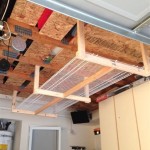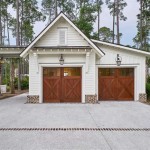How To Prepare and Paint a Concrete Garage Floor
Painting a concrete garage floor can significantly enhance its appearance, durability, and resistance to stains and chemicals. Proper preparation and application are crucial for achieving a long-lasting and attractive finish. This article outlines the necessary steps to effectively prepare and paint a concrete garage floor.
Cleaning the Floor
Thorough cleaning is essential to ensure proper paint adhesion. Multiple methods can be employed depending on the floor's condition:
*
Sweep and Vacuum:
Begin by removing loose debris, dust, and dirt. A thorough vacuuming is recommended to extract particles lodged in cracks or crevices. *Degreasing:
Oil and grease stains must be removed using a concrete degreaser. Follow the manufacturer's instructions carefully and allow sufficient dwell time for optimal effectiveness. *Acid Etching:
Etching the concrete with a mild acid solution like muriatic acid creates a slightly roughened surface that promotes paint adhesion. Apply the solution according to the manufacturer's directions, ensuring proper ventilation and safety precautions. After the etching process, thoroughly rinse the floor with clean water and allow it to dry completely. Pressure washing can aid in rinsing the etched floor effectively. *Detergent Scrubbing:
For floors with minimal staining or grease, a heavy-duty detergent scrub can be sufficient. Use a stiff-bristled brush and scrub the entire surface diligently. Rinse thoroughly and allow to dry completely.Repairing Cracks and Imperfections
Before painting, address any cracks, chips, or imperfections in the concrete surface to create a smooth and uniform base.
*
Crack Repair:
Use a concrete patching compound specifically designed for cracks. Follow the manufacturer's instructions for mixing and application. Allow the patch to dry and cure completely before proceeding. *Chip Repair:
Similar to crack repair, use a suitable concrete patching compound to fill any chips or divots. Ensure a smooth and level finish to prevent uneven paint application. *Surface Leveling:
For larger imperfections or uneven areas, a concrete resurfacer may be necessary to create a level surface. Apply the resurfacer according to the manufacturer's instructions and allow it to cure fully.Priming the Floor
Priming is a critical step that enhances paint adhesion and ensures a uniform and durable finish. Choose a primer specifically designed for concrete and garage floors.
*
Primer Selection:
Epoxy-based primers are highly recommended for their excellent adhesion and durability. They effectively seal the concrete and prevent moisture penetration. *Application:
Apply the primer evenly using a roller or brush, ensuring complete coverage of the entire surface. Follow the manufacturer's instructions regarding drying time between coats, if applicable. *Drying Time:
Allow the primer to dry and cure completely according to the manufacturer's recommendations before applying the paint.Painting the Floor
Careful selection and application of the paint are crucial for a successful project. Choose a high-quality epoxy-based paint designed for garage floors.
*
Paint Selection:
Epoxy-based paints are ideal due to their excellent durability, chemical resistance, and resistance to abrasion. *Mixing:
If using a two-part epoxy paint, mix the components according to the manufacturer's instructions thoroughly. Be precise with measurements to ensure proper curing and performance. *Application:
Apply the paint evenly using a roller designed for epoxy coatings, working in manageable sections. Maintain a wet edge to prevent lap marks. *Multiple Coats:
Most epoxy paints require two coats for optimal durability and coverage. Follow the manufacturer's instructions regarding drying time between coats. *Drying and Curing:
Allow the paint to dry and cure completely according to the manufacturer's recommendations before subjecting the floor to traffic or heavy objects. This curing process can take several days, depending on the paint type and environmental conditions.Safety Precautions
Safety is paramount when working with chemicals and power tools.
*
Ventilation:
Ensure adequate ventilation throughout the process, especially during cleaning, etching, and painting, as fumes can be harmful. Open windows and doors or use fans to circulate air. *Protective Gear:
Wear appropriate safety gear, including gloves, eye protection, and a respirator, to prevent contact with chemicals and dust. *Disposal:
Dispose of chemical waste properly according to local regulations.Final Considerations
Several additional considerations will contribute to the success of the project.
*
Temperature and Humidity:
Ideal application temperatures for most epoxy paints are between 50°F and 90°F with low humidity. Avoid painting in direct sunlight or during periods of high humidity. *Surface Preparation:
Adequate surface preparation is the most crucial step in ensuring a successful and long-lasting paint job. Take the time to clean, repair, and prime the surface thoroughly. *Product Instructions:
Always follow the manufacturer's instructions precisely for each product used, including cleaners, etchers, primers, and paints. This ensures optimal performance and durability of the final finish.
How To Paint Garage Floor Regal Paints Industrial Protective Ltd

How To Paint Garage Floors With 1 Part Within The Grove

How To Paint A Garage Floor Clean And Scentsible

Painting Your Garage Floors Do S Dont Making Pretty Spaces Blog

How To Use Garage Floor Paint Transform Your Home

How To Paint A Garage Floor Clean And Scentsible

How I Painted My Concrete Garage Floor With Sheild Before After True Value Hardware

Diy Garage Floor Coating

Garage Floor Coat Comprehensive Step By Guide Builds Maz

Painting Your Garage Floors Do S Dont Making Pretty Spaces Blog
Related Posts








